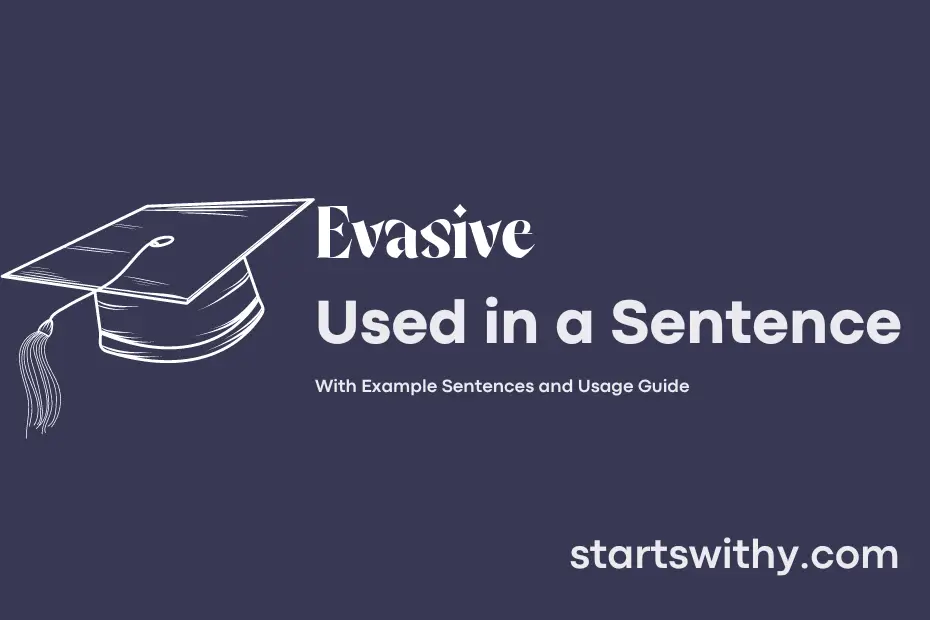Have you ever struggled to pin down the true meaning behind someone’s words or actions? This is where the concept of being evasive comes into play. To put it simply, being evasive means avoiding giving a direct answer or being deliberately vague in order to dodge a question or situation.
It can often be frustrating to deal with individuals who are evasive, as their lack of straightforwardness can lead to confusion and miscommunication. Identifying evasive behavior is important in order to navigate interactions effectively and ensure clarity in communication.
7 Examples Of Evasive Used In a Sentence For Kids
- The squirrel was being evasive when we tried to catch it.
- The butterfly was evasive and kept fluttering away from us.
- The clever fox was evasive and managed to escape from the hunter.
- The mischievous kitten was evasive during playtime.
- The bird was evasive and flew away when we approached it.
- The slippery fish was evasive and hard to catch in the pond.
- The rabbit was evasive and hopped away quickly when we tried to pet it.
14 Sentences with Evasive Examples
- Evasive strategies are not advisable when it comes to studying for exams.
- It is better to seek clarification from professors rather than giving evasive answers in assignments.
- Using evasive tactics to avoid group projects will only lead to a lower grade.
- It is important to be honest in interviews instead of resorting to evasive responses.
- Trying to avoid discussions on important topics by being evasive will not help in broadening your knowledge.
- Professors can easily detect when students are being evasive in class discussions.
- Submitting evasive and incomplete assignments reflects poorly on your work ethic.
- It is better to face a difficult question head-on rather than being evasive in college presentations.
- Communication skills are crucial in college, as being evasive can lead to misunderstandings.
- Utilizing evasive behavior to avoid responsibility in group projects will harm your reputation among peers.
- It is wise to seek help when facing academic challenges rather than being evasive about your struggles.
- Participating actively in discussions and debates will help you develop critical thinking skills and avoid being evasive.
- Procrastination often leads to evasive behavior when deadlines start approaching.
- Being evasive in group study sessions will hinder the progress of the entire group.
How To Use Evasive in Sentences?
To evasively = “evade” or avoid something by being indirect or elusive. Here’s a guide on how to use evasive in a sentence:
-
Identify the Context: Before using evasive in a sentence, understand the situation or scenario where someone is avoiding a direct answer or action.
-
Choose the Right Context: Make sure the situation calls for the use of evasive. For example, if someone is dodging questions about their actions, that could be a good context.
-
Forming a Sentence: Once you have the context, construct a sentence using evasive. For instance, “He responded evasively when asked about his whereabouts last night.”
-
Check for Clarity: Ensure that the sentence clearly conveys the message of avoiding or dodging. If needed, adjust the wording to make it more understandable.
-
Variation in Use: Experiment with different sentence structures and contexts to become more familiar with using evasive effectively in your communication.
-
Practice Makes Perfect: Repeatedly using evasive in sentences will help you gain confidence and improve your sentence construction skills.
In conclusion, mastering the usage of evasive can enhance your communication skills by allowing you to express situations where evasion or avoidance is crucial. Practice regularly to become more adept at incorporating evasive in your sentences.
Conclusion
In conclusion, the presence of evasive sentences in communication can hinder clarity, honesty, and effective understanding between individuals. These types of sentences, which aim to avoid direct answers or conceal the true meaning, often lead to confusion and misinterpretation. It is important to recognize and address evasive language in conversations to promote transparency and open communication.
By being mindful of using straightforward and direct sentences, individuals can enhance the quality of their interactions and build trust with others. Clear and concise communication fosters better relationships, resolves conflicts more efficiently, and promotes effective collaboration in various aspects of life. Therefore, avoiding evasive sentences and opting for transparent communication can lead to more meaningful and productive interactions.



